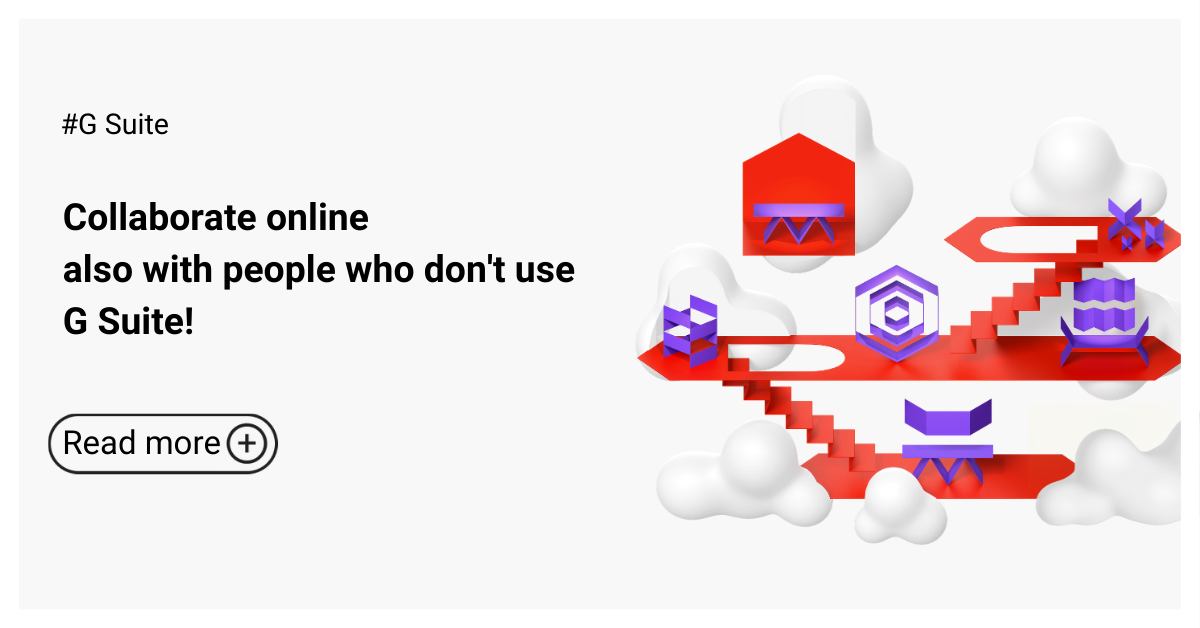Google Workspace
Empower employees and support employee initiative with G Suite
IT is all about people. Often we tend to forget that all the IT tools, applications and programmes are here because of people and for people: clients, shareholders, management and employees (no matter what the exact order is).
A few years ago, talking about employee engagement or empowerment was pretty much just management babble; something you have to mention because it looks good in an annual report or in the speeches at the conferences. However, in the end the priorities went to systems, processes and costs.
Times have changed. Nowadays, with low unemployment rates and great difficulty finding good qualified loyal employees, a new people-centric era has begun. Clients want more that just a standardised product and average service.They want the best, they want it fast, modular and affordable, followed by exceptional service.
And employees, who are as demanding as clients, want a similar experience at work. They expect more than just a job from 9 A.M. till 5 P.M., regular pay, company mobile phone and paid holidays. They want influence, they want to play an active role and to be able to show initiative. They want to grow.
Employers who want to satisfy their clients and stay relevant in the fast changing market, while at the same time finding and keeping good employees, see the necessary helping hand in digital transformation.
“71% of CEOs see technology change as the #1 external force that could most impact their organisation over the next 3-5 years,” according to an IBM survey of CEOs.
The cloud is the most innovative and agile way to change technology for internal operations and client services. Revolgy clients typically roll out the cloud step-by-step: first, they move internal communication and collaboration to the cloud, followed by a transition of data storage and processing to a faster and scalable cloud environment.
Google’s G Suite is a very popular set of tools for professional communication, collaboration and business processes transformation. The huge advantage of G Suite is that people know it and are used to it from their private lives. So tools like Gmail, Google Drive or Hangouts are nothing new; what is new is the incorporation of these tools into their everyday business processes and working systems.
Reasons why companies go to the cloud could be viewed from several perspectives.
1. A need for efficiency improvement
The old, linear way of working, consisting of sending emails and waiting for answers, revising numerous versions of documents, and limited communication, is simply outdated and blocks the development of the organisation.
2. Support of collaboration within distributed teams.
Use case #1: Solving the problem with missing information between branches
One of our clients, a large Central European bank, has three headquarters plus hundreds of branches across the country. While working on projects where people from various locations took part, the bank faced the problem of information flow.
There was always someone who was not in the loop: people missed important information, milestones had not been correctly communicated, and tasks had been delayed. There was dissatisfaction among the team members, and due to previous gaps, the team did not leverage their capabilities.
The introduction of G Suite to the project management process improved the information flow and innovation loop immensely: all documents are shared on Google Drive; project calendars marking all important events and deadlines are shared with every team member; regular Hangout video calls keep up team spirit and enable regular updates, regardless of where the people are located.
Group chat enables fast communication, updates and feedback gathering in one click. Shared budgets on Google Sheets give an instant overview of expenditure and Google Site can be used to centralise information from all the previously-used resources.
As a result, the team efficiency improved and most importantly, its members reported a greater deal of satisfaction and motivation.
3. Need for multi-way communication and employee empowerment
The old-fashioned way of communication is simply not enough anymore. Employees expect more than following instructions; they want to contribute to internal communication and co-create the company’s strategy.
Use case #2: Need for internal social network
Another banking client of ours is very keen on using Google+ communities. What is Google+ actually? An internal social network that can be locked exclusively for your domain and provide people with all the benefits of social networking: writing posts, creating communities, having discussions, liking and linking to various content from the G Suite world (docs, presentations, YouTube videos, polls, Google Drive structures etc.).
Our client’s employees launched many communities related to various projects, topics and interests. One of them was dedicated to IT and innovation. There came a moment when they wanted to introduce a new ATM system. The IT department posted the information to the community, asking members for feedback. They received a very detailed comment from one of the bank’s employees from a small town far from the capital city. This guy was interested in ATM systems and even wrote a paper on it previously. It was obvious that he had more extensive knowledge on the topic than anyone else on the project team. He started to cooperate with the team closely, eventually moving to the capital city where he has now become one of the innovation leaders in the bank.
This beautifully shows how modern cloud tools empower people. Without these tools, there would be no community, and the company wouldn’t even know about the existence of such special knowledge within the ranks of its employees. But it takes more than just a tool: it takes courage. The IT guys were not afraid to allow anyone to comment, risking that there could be some negative reactions. They took the risk, and the benefit was worth it.
4. Ways to support employee’s growth and sharing best practices
Majority of employees want to grow, learn new things and move further with their career. However, not everyone can be a manager (and not everyone should be one), and therefore, it is important to develop opportunities for horizontal growth, gaining expertise, and sharing it with others. G Suite tools enable us to do so.
Use case #3: No problems with internal communication anymore
Another client of Revolgy, a financial institution with thousands of employees analysed its expenditure on employee trainings and realised the numbers are much higher than he expected. The HR team started considering how to take advantage of the existing knowledge and capabilities amongst its employees.
Using G Suite, they previously established a Google+ community called “Banking University” where people could enrol to different courses, discuss the content and share tips for (self)development. Now they decided to add an option for the employees to offer to share their own skills and knowledge with the rest of their colleagues. We mean hard skills (such as working professionally with some backbone banking systems, CRM’s, etc.), as well as soft skills (e.g. presentation skills).
The HR Training team created a simple process: the employees fill the form on the G+ community describing what knowledge they want to share, and if the topics seem attractive, HR helps them to develop a prototype course. Based on the feedback, everybody benefits from that scheme. Employees learn new skills while the trainer receives professional support in developing the course curriculum and also improves his/her soft skills.
This approach helps spread existing best practices amongst employees, gives people a chance to learn new things and grow to be experts, as well we saves the company expenses for employee trainings.
Cloud tools such as G Suite are an amazing enabler to the development of employees and the company. Implementation of collaborative tools however, is just the beginning: the real business transformation and people transformation comes with leveraging advantages of modern collaboration tools.
Good quality communication and collaboration give people power. If you dare to share the power, enable the personal initiative and individual responsibility, your people will feel like more than just employees and your business will receive huge energy boost.
To fully benefit from these powerful collaboration tools while ensuring your company’s data remains protected, it’s crucial to implement robust security measures. Revolgy offers expert Google Workspace security management services that help safeguard your digital workplace, maintain compliance, and protect sensitive information across all G Suite applications.
FAQs
Q1: What major shift in business focus does the 2018 article highlight?
The article describes a shift away from prioritizing only systems, processes, and costs towards a new “people-centric era”, driven by difficulties in finding qualified employees and heightened expectations from both customers and staff.
Q2: What do employees want from their work environment beyond traditional compensation and benefits, according to the text?
Employees seek influence, the opportunity to play an active role, the ability to show initiative, and chances to grow professionally.
Q3: How are employers responding to the changing demands of clients and employees?
Many employers are turning to digital transformation, particularly leveraging cloud technologies, to adapt their internal operations and client services to meet these new expectations and remain competitive.
Q4: What is the typical first step Revolgy clients take when moving their IT infrastructure to the cloud?
They usually begin by migrating their internal communication and collaboration tools to the cloud.
Q5: Why was G Suite considered a popular choice for businesses at the time of the article?
G Suite provided a suite of tools for professional communication, collaboration, and business process transformation. A key advantage noted was that many people were already familiar with its core components like Gmail, Google Drive, and Hangouts from personal use.
Q6: What were the four primary reasons discussed for companies adopting cloud solutions like G Suite?
The reasons highlighted were: 1) The need to improve efficiency over older, linear ways of working; 2) To support collaboration among geographically distributed teams; 3) The need for multi-way communication and employee empowerment; 4) Seeking ways to support employee growth and the sharing of best practices internally.
Q7: How did G Suite reportedly help a large bank with multiple locations improve project collaboration?
By using tools like Shared Drive for documents, shared Project Calendars, regular Hangouts video calls, Group Chat for quick updates, shared Sheets for budgets, and Google Sites for centralizing information, the bank overcame issues with information flow, missed deadlines, and improved team efficiency and satisfaction.
Q8: How did another banking client leverage G Suite (specifically Google+) for employee empowerment?
They used Google+ communities as an internal social network. When the IT department sought feedback on a new ATM system via a community post, they discovered an employee in a remote branch with deep expertise on the subject, who then significantly contributed to the project and advanced within the company.
Q9: What did the success of the Google+ community example require from the IT department?
It required the courage to allow open comments from anyone, risking potential negative feedback, in order to gain valuable insights and employee contributions.
Q10: How did a financial institution use G Suite to foster internal knowledge sharing and reduce training costs?
They expanded an existing Google+ community (“Banking University”) to allow employees to propose and offer training sessions based on their own hard skills (like specific banking systems) and soft skills (like presentation abilities), with HR support for course development.
Q11: What is the article’s main point regarding the implementation of collaborative tools like G Suite?
Implementing the tools is just the first step. The real business and people transformation occurs when companies actively leverage these tools to empower employees, share power, encourage initiative, and foster individual responsibility, which in turn boosts the business.



